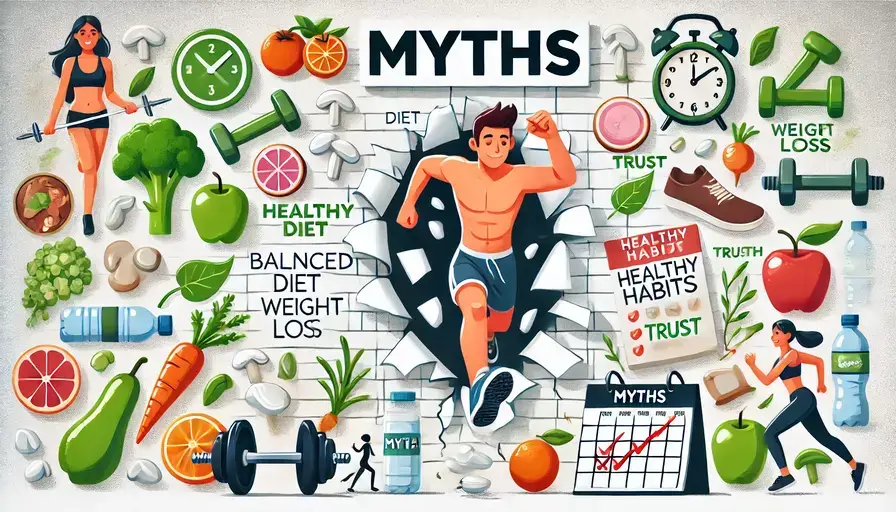Understanding Elimination Diets: Identifying Food Sensitivities
Explore the concept of elimination diets designed to help identify food sensitivities and intolerances, and discover how they may alleviate symptoms.
Posted by
Related reading
Overcoming Weight Loss Plateaus: Understanding and Solutions
Learn what weight loss plateaus are, why they occur, and discover effective strategies to push past them and achieve your weight loss goals.
Mastering Meal Planning: Your Ultimate Guide to Healthier Eating
Discover the art of meal planning to save time and money while promoting healthier eating habits. Follow these simple steps for success.
Addressing Childhood Obesity: Practical Tips for Families
Explore effective strategies for combating childhood obesity and promoting healthy habits within families.
Finding Your Personal Motivation to Lose Weight
Discover how to identify your personal reasons for losing weight and stay motivated throughout your journey towards a healthier lifestyle.
Healthy Cooking at Home: 6 Strategies for Weight Loss
Discover the key benefits of home cooking and practical tips to make healthy meals that support weight loss goals without sacrificing flavor.

What Are Elimination Diets?
Food plays a crucial role in fueling our bodies with essential nutrients; however, certain foods can lead to adverse reactions. For individuals experiencing digestive issues after meals, the cause could be a food allergy or an intolerance, which affects approximately 15 to 20 percent of the population. To help identify potential culprits, healthcare providers may recommend an elimination diet. These diets are tailored to individual needs, focusing on removing specific foods that could be responsible for discomfort.
The Concept of Elimination Diets
An elimination diet is a structured eating plan that temporarily excludes certain foods or food groups. This approach is especially helpful for those unsure of what is causing their digestive problems. By eliminating suspected foods for a period, followed by a gradual reintroduction, individuals can pinpoint specific triggers for their symptoms. It’s essential to note that not all digestive issues stem from food, so collaborating with a healthcare professional before starting an elimination diet is paramount.
Distinguishing Food Allergies from Intolerances
While food allergies and intolerances both lead to adverse reactions, they operate through different mechanisms. A food allergy involves an immune response where the body mistakenly identifies a harmless substance in food as a threat, producing antibodies that cause various symptoms. Reactions can affect the skin, digestive system, respiratory tract, or may even lead to anaphylaxis, a life-threatening condition. The FDA identifies the eight most common allergens, which include milk, eggs, fish, shellfish, tree nuts, peanuts, wheat, and soy.
Conversely, food intolerance occurs when the body struggles to digest a specific food. This may be due to a lack of enzymes needed to break down food components or a negative reaction to additives. Symptoms can include nausea, stomach cramps, gas, bloating, and more. Unlike allergies, there are no standard medical tests for food intolerances, so elimination diets are often deployed to help identify them.
Implementing an Elimination Diet
Embarking on an elimination diet should be undertaken under the guidance of a healthcare professional or a registered dietitian. The diet typically unfolds in two main phases across several weeks.
1. The Elimination Phase
This initial phase, lasting two to three weeks, requires the removal of specific foods that are suspected to be causing symptoms. For instance, to investigate lactose intolerance, all dairy products would be eliminated. It generally takes this duration for the body to cleanse itself of the eliminated foods, during which symptoms may begin to improve.
2. The Reintroduction Phase
If symptoms show improvement during the elimination phase, this stage is designed to identify the exact foods responsible. Small quantities of eliminated foods are reintroduced every few days, allowing individuals to monitor their reactions and determine which foods they can tolerate.
Types of Foods in an Elimination Diet
There is no universal list of foods suitable for every elimination diet, as plans are highly individualized. However, here are some typically safe options that may be included:
- Vegetables: Generally tolerated, though individuals should be cautious with certain types like tomatoes and cruciferous vegetables if sensitivity is suspected.
- Fruits (Excluding Citrus): Most fruits are safe, but citrus fruits are often avoided due to their acidity.
- Rice and Potatoes: Both provide necessary carbohydrates without gluten, making them safe options.
- Meats: Chicken, turkey, and pork are usually safe. Red meat may be problematic for some, due to certain compounds.
- Plant-based Milk: Alternatives like almond or oat milk can be included unless there is an allergy to nuts.
Conversely, a list of foods to avoid may typically include:
- Dairy: If lactose intolerance is suspected, cutting out all dairy items can provide clarity.
- Eggs: Eggs are found in many products, so vigilance is necessary.
- Fish and Shellfish: Care needs to be taken as allergic reactions can occur even after years of consumption.
- Gluten-containing Grains: Avoiding wheat, barley, and rye is essential for those suspected of gluten issues.
- Tree Nuts and Peanuts: Often allergens, these should be removed during the elimination phase.
- Soy: Similarly, soy should be eliminated if suspected to trigger symptoms.
Benefits of Conducting an Elimination Diet
When undertaken correctly, elimination diets can reveal which foods contribute to unwanted symptoms, providing a clearer path to relief. Potential benefits include:
- Reduction of Irritable Bowel Syndrome (IBS) Symptoms: Identifying triggers can alleviate persistent digestive discomfort.
- Mitigation of Bloating: Eliminating certain offenders can significantly reduce feelings of fullness and gas.
- Management of Abdominal Pain and Diarrhea: Identifying and removing problematic foods can lessen these challenging symptoms.
- Relief from Migraines: Some individuals report fewer migraines after dietary adjustments, although further research is needed in this area.
Considerations and Risks
Despite the benefits, elimination diets can present potential risks, which is why professional guidance is critical. Possible drawbacks include:
- Unintentional Weight Loss: The restrictive nature of elimination diets can lead to inadvertent weight loss, particularly if calorically dense foods are cut out.
- Nutritional Deficiencies: Severely limiting food variety can lead to deficiencies in essential nutrients.
- Discomforts like Headaches and Constipation: These can arise from inadequate calorie or fiber intake.
- Developing an Unhealthy Relationship with Food: For those with a history of eating disorders, the restrictive nature may exacerbate issues.
The goal of an elimination diet is to help identify food sensitivities and improve overall well-being. However, it’s crucial to remember that individual nutritional needs can vary greatly. If you believe that certain foods are affecting your health, consulting with a medical professional is vital to ensure a safe and effective approach.
The journey to understanding food sensitivities is not only about elimination; it’s about empowerment and making informed choices for a healthier life.
Other Interesting Articles

How Protein and Fiber Can Help You Feel Fuller Longer
Discover how incorporating protein and fiber into your meals can enhance feelings of fullness, support your weight goals, and improve overall wellness.

Unlocking Weight Loss Through Walking: Your Guide to Fitness
Explore the powerful benefits of walking for weight loss and overall health, along with practical walking plans to help you get started.

Overcoming Weight Loss Plateaus: Understanding and Solutions
Learn what weight loss plateaus are, why they occur, and discover effective strategies to push past them and achieve your weight loss goals.

What Are Some Common Myths About Weight Loss?
Discover the truth behind common myths about weight loss and learn evidence-based strategies for effective weight management.